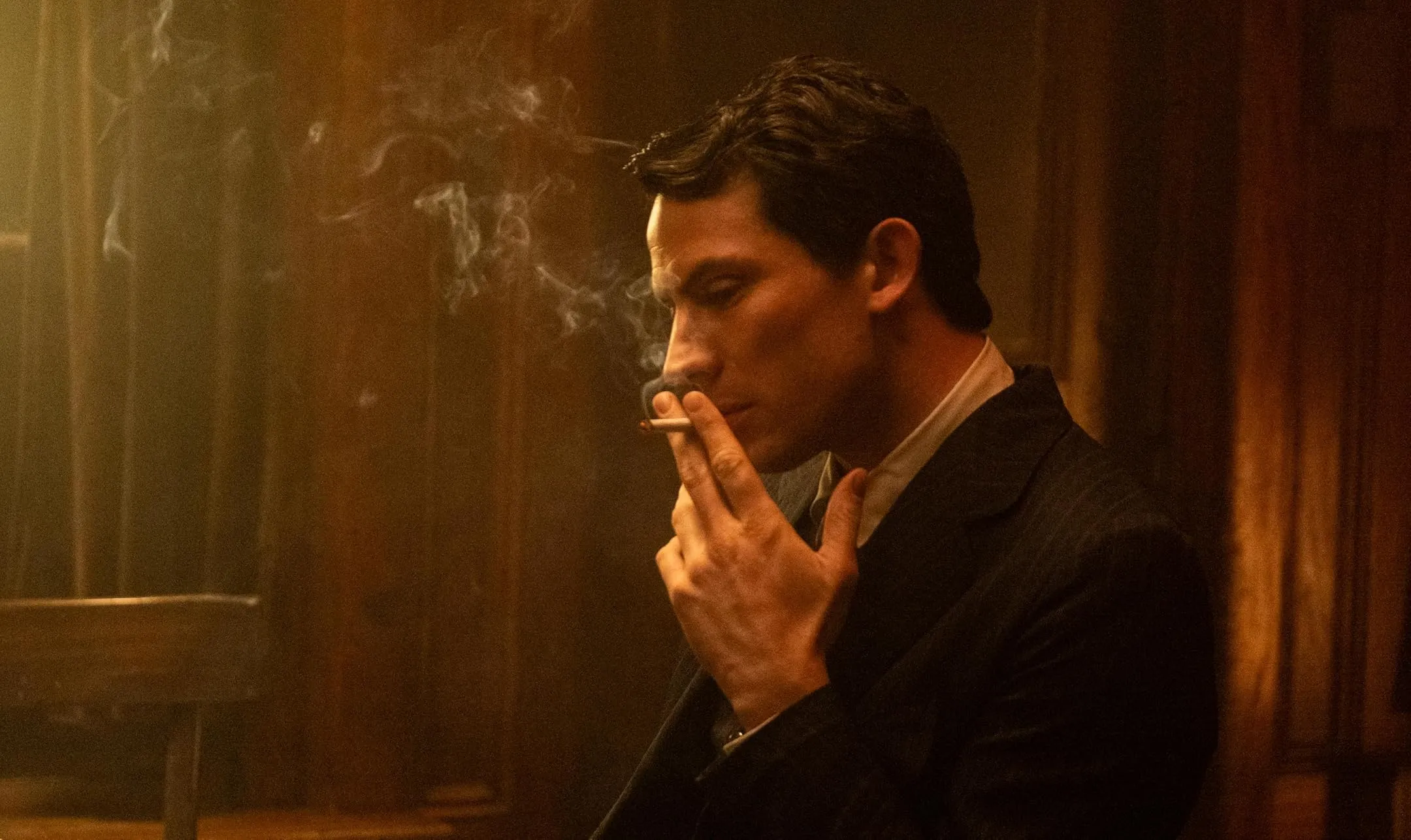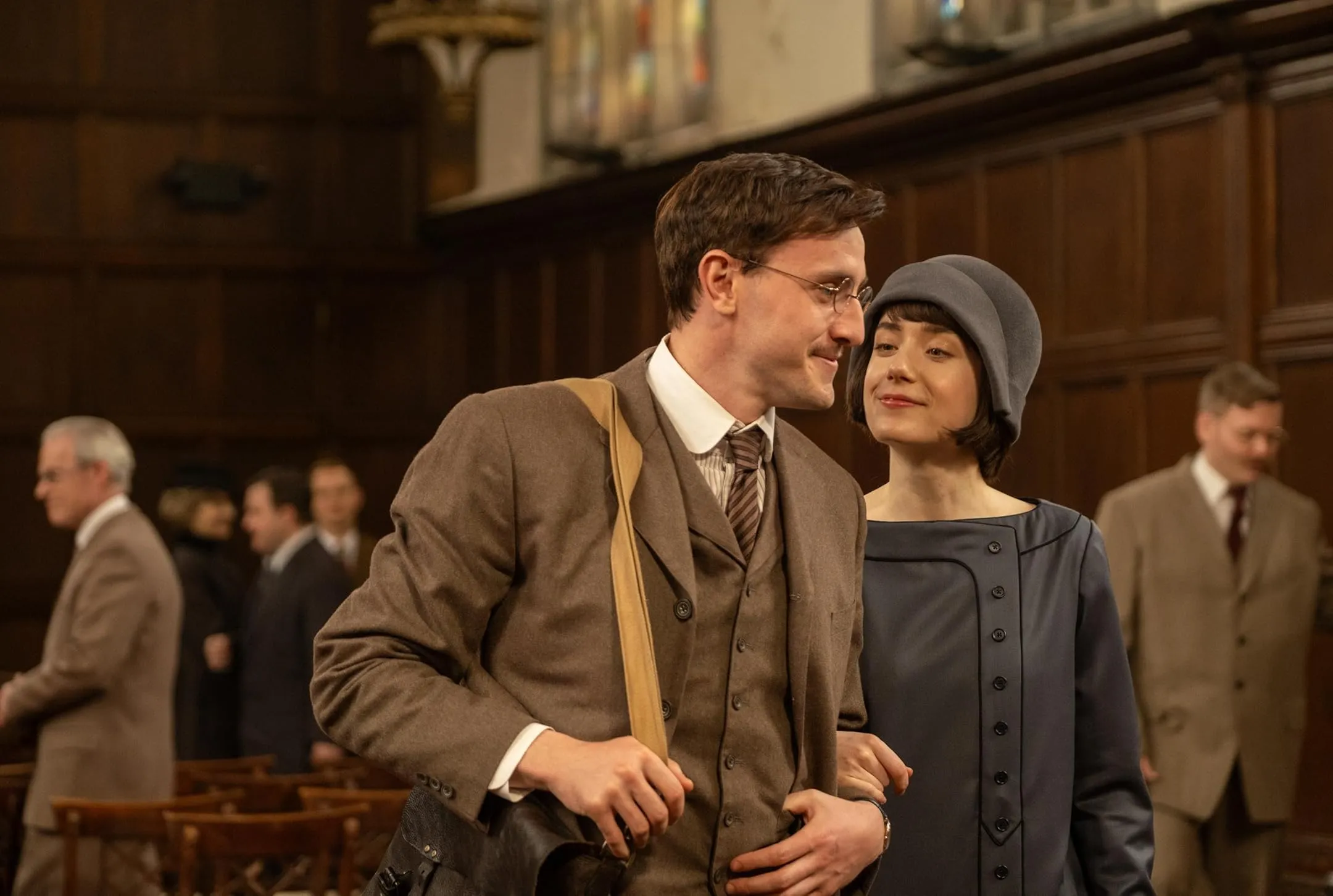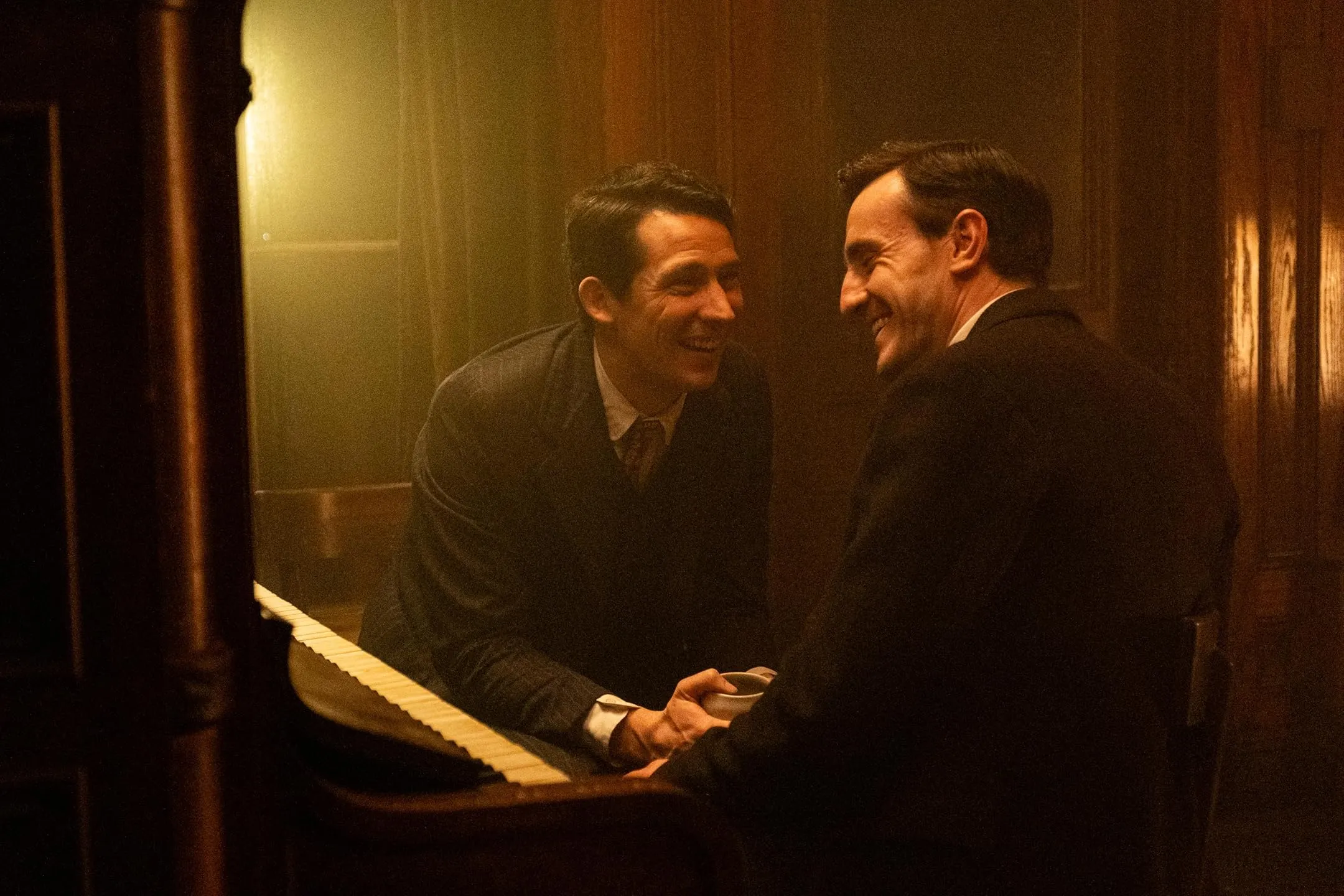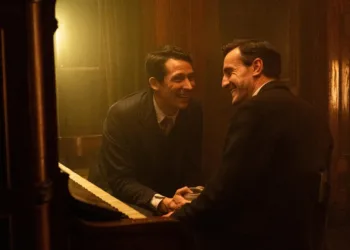In the shadow of the Great War, The History of Sound emerges as a hushed elegy—a canvas of frost-tipped pines and crackling wax cylinders that carries the faint pulse of forbidden longing. Lionel, a Kentucky farm boy gifted with synaesthesia, and David, a Boston Conservatory pianist whose fingers summon secrets from ivory keys, collide in 1917 during a midnight serenade. Their connection unfolds not in grand proclamations but in the fragile act of pressing a needle to cylinder, as if seeking to trap the rarest thing of all: a moment untainted by time.
This film crafts its palette in muted grays and sepia whispers, each frame composed like a silent sonnet. The camera lingers on Lionel’s haunted gaze—his mouth tasting the bitter chord of memory—while the forest around them listens, as though the trees themselves remember every tremor of their hearts. In these painterly tableaux, sound becomes a repository for absence, echoing questions we cannot quite voice: Can love survive when the instruments of memory themselves decay? What shape does identity assume when every note is tinged with both desire and dread?
As creatures of sound and silence, we are invited to consider how history reverberates within us. Does the act of recording preserve truth—or conjure ghosts we cannot release?
Temporal Resonances and Fragmented Echoes
Oliver Hermanus structures The History of Sound as a palimpsest of memory, peeling back layers of time to expose the raw sinews of loss. The prologue, whispered in Lionel’s child-voiceover, plants the seed of synesthesia—notes as colours, chords as tastes—before the film fractures into 1917 Boston. Here, the narrative splinters into jump cuts: one moment, a smoky conservatory bar; the next, the stillness of a Maine forest; then the clamour of wartime trenches; all the way to Lionel’s autumnal reflection in 1984. Each era bleeds into the next, like grooves on a worn cylinder.
The early sections breathe with deliberate slowness, introducing Lionel and David in soft chiaroscuro. The world unfolds at dawn-light pace: a piano chord rings; a field recording crackles; their hands brush over wood and wax. In these languid frames, the film meditates on the ontology of sound—does it survive the act of capture, or does the very needle wound its essence?
Midway, the narrative dissolves into episodic detours. We accompany Lionel through the pine shadows of Maine, traipsing between cottages to record dying folk songs. Then, abruptly, we’re in the sunlit courtyards of Rome, the candlelit libraries of Oxford—each detour a philosophical question about belonging: Where does the wanderer truly rest? Does exile sharpen longing or dull its edge?
In the final act, the older Lionel returns in voice and visage. The coda’s reflective quietudes reframe earlier gestures, amplifying their ache. Yet these leaps pose risks: the expansive timeline sometimes drifts free of emotional gravity, and certain side passages—though suffused with painterly beauty—teeter toward meandering.
Throughout, Hermanus binds eras with recurring motifs: the wax cylinder, the canvas of the tent, the echo of a single folk lament. These symbols are the film’s connective tissue, yet the very insistence on them raises an existential query: when we circle back to the same image, do we find deeper meaning—or merely trace the outlines of our own yearning?
Souls in Silence and Shade
Paul Mescal’s Lionel moves through The History of Sound like a ghost in search of an echo—each pause pregnant with unspoken longing. His silences speak in decibels, the slack of his jaw mirroring the space between notes he can taste on his tongue. In early scenes, the wide-eyed farm boy imbued with chromatic sensations—B-flat’s tang of bitterness, a high A’s muted teal—shines with youthful wonder.
By the film’s close, that synesthetic spark flickers under the weight of years: Lionel’s posture curves inward, his voice-over gravelled with memory’s ache. Mescal traces this arc without spectacle; instead, small shifts—an exhalation too heavy, a glance that lingers—chart the passage from innocent marvel to solemn archivist of his own grief.
Josh O’Connor’s David is the sun around which Lionel orbits. He radiates boldness in concert halls yet harbors a quiver beneath tailored waistcoats—a quiet tremor that surfaces in furtive glances. Though David vanishes for stretches, his presence resonates long after; a single letter, a tremor in Lionel’s lips, and the pianist’s image unfurls in moonlit tents. O’Connor conjures a latent ache that propels Lionel toward self-invention and self-restraint in equal measure.
Supporting figures punctuate Lionel’s trajectory like minor chords. His mother’s stern reproach on his farm return briefly cracks his composure—a reminder of roots left behind. In Europe, Clarissa and her circle reflect a restless spirit: their laughter feels worldly, unsaturated by Lionel’s nocturnal hues. When Chris Cooper’s older Lionel intones the opening narration, his measured cadence anchors us, offering the hollow echo of a lifetime spent chasing vanished harmonies.
The alchemy between Mescal and O’Connor crystallizes in three key tableaux: the smoky bar’s first chord, where their eyes lock like twin reflections; the train-station farewell, where trembling fingers betray their resolve; and the tent’s confessional dark, where breath becomes touch. In these interstices—shared breaths, converging shadows, whispered lines—the film finds its deepest resonance, reminding us that the space between two souls may be the only canvas wide enough to hold their truths.
The Poetics of Light and Silence
In The History of Sound, every frame feels like an oil sketch torn from memory. Alexander Dynan’s cinematography bathes the Maine wilderness in dawn’s pale gold, letting mist swirl like breaths half-remembered.
In Europe, the palette shifts to muted ochres and ash—sunlight filtered through timeworn glass—so that Rome’s piazzas and Oxford’s libraries become nocturnes in daylight. These painterly compositions do more than please the eye; they ask, “What remains when colour itself fades?”
The wax-cylinder recorder emerges as a talisman throughout—the needle poised above its metallic face, ready to gouge a moment into permanence. Production design honours that fragile ritual: weather-beaten cottages, crackling hearths, and simple wood grain evoke an era unguarded by modern gloss. Interior walls carry the patina of use, not artifice, grounding the film in tactile truth even as its themes drift toward the philosophical.
Costumes and makeup trace subtle arcs of transformation: Lionel’s threadbare wool coat, its fibres frayed by snow and solitude, contrasts sharply with his crisp conservatory tuxedo—two lives stitched together by a single thread of longing. David’s tailored vests and pocket watches speak to propriety, yet his loosened collars in the field signal a willingness to shed social moorings. Such wardrobe choices, almost imperceptible, chart shifts in identity more acutely than any line of dialogue.
Editing weaves past and present with the precision of a composer: a flicker from youth to age—Lionel’s childlike gaze smudged into the professor’s weary eyes—occurs mid-note, as a folk melody dissolves into echo. Sound-driven cuts—cylinder crackles, piano chords—dictate rhythm, transforming transitions into thematic beats. In these rhythmic edits, time collapses and expands, like a breath held too long.
The overall atmosphere is one of suspended elegy: the visual symphony of light, costume, and set design converges into a melancholic refrain. Here, every shadow questions what we lose when love is recorded—and every beam of light reminds us of beauty’s transience.
The Resonance of Absence and Presence
Sound in The History of Sound is neither mere ornament nor background texture—it unfolds as a philosophical inquiry into the nature of being. Oliver Coates’s score drapes itself around traditional ballads like a spectral shawl, weaving original motifs through the mournful strains of “The Unquiet Grave,” where the dead plead for peace while the living’s grief disturbs their rest. These songs are not decorative; they become thematic lodestones, each lyric a question about loss and remembrance.
Diegetic sound emerges as a fragile confidant. The crackle of wax cylinders, captured close and intimate, reminds us that every recording is an act of violence against time—a needle gouging memory into metal. The hiss of snow-laden pines, the distant call of loon or thrush, these ambient voices wrap the lovers in a sonic cocoon that tastes of damp earth and cold wind. In such moments, the forest itself seems complicit in their secret communion.
Lionel’s synesthesia offers another layer of inquiry: a B-flat note curls on his tongue like charcoal, while a high D fades into pale lilac at the edges of consciousness. His voice-over ruminations—colour and flavour transposed into musical intervals—invite us to wonder whether perception is ever objective, or if it is haunted by personal longing. The film’s insistence on these sensory overlaps challenges us to consider: do we hear the world, or does the world hear us?
Silence, too, becomes a deliberate punctuation. The absence of music in tender pauses heightens the ache between characters, as though emptiness itself carries weight. Then, at an unexpected turn, Joy Division’s “Atmosphere” erupts—a temporal rupture that shocks the pastoral reverie into modern consciousness. Its stark notes fracture the film’s period veneer, suggesting that desire, like history, resists containment.
Ultimately, the final piano scene stands as a mnemonic miracle. Lionel’s aged hands coax from ivory keys the same notes he once tasted and saw in colour, merging past and present. In that echo, we confront the most unsettling question: does art preserve the soul, or does it just prolong its solitude?
Echoes of Absence and Becoming
Memory in The History of Sound is a brittle artifact, much like the wax cylinder itself: beautiful, fragile, and destined to crack. The act of recording becomes a meditation on impermanence, each groove gouged into metal an elegy for what slips away. Lionel’s recollections shimmer against the raw texture of lived moments—his mind a palimpsest where past summer nights in Maine overlap with snow-laden walks back home. Yet memory is no faithful archivist; it distorts as much as it preserves, and Hermanus leans into that uncertainty.
At the heart of the film lies a love that thrives in the shadows. Silence guards identity even as passion seeks light. In public spaces—train platforms, forest clearings—the lovers move like conspirators in half-hidden worlds, their intimacy a secret geography. These private gestures amid open landscapes ask whether love can unfold without exposure, and whether secrecy itself carries its own price.
The pursuit of authenticity threads through the folk-song recordings, paralleling Lionel’s search for self. Each traditional ballad is a shard of cultural ownership, unearthed from rural lips and stitched into scholarly tomes. Yet the very act of collecting imposes a hierarchy: whose voice is preserved, and who becomes historian versus muse? Class divisions ripple beneath Lionel’s noble impulses, reminding us that art often mirrors the world’s inequities.
Time’s passage fractures the lovers’ arc from tender idealism to the brittle ache of hindsight. Youthful ardor yields to reflective regret as decades unfold; the film’s structure—leaping from 1917 to the 1980s—underscores the longing that persists beyond flesh and breath. Aging Lionel, haunted by sonorous ghosts, embodies the weight of years unmoored from original fervor.
Visual symbols anchor these themes: the cylinder with its circular promise of return, the tent as both sanctuary and labyrinth, the train station threshold between presence and absence. Colour bleeds through Lionel’s synesthetic vision—B-flat’s bitter ochre, a high C’s fleeting jade—reminding us that perception itself is textured by desire, shaped as much by what we seek as by what we find.
Echoes of an Era Unspoken
In the aftermath of the Great War, America trembled between fresh hope and buried horrors. Queer love in the 1910s and ’20s existed in whispers—letters tucked inside bespoke gloves, stolen kisses in shadowed corridors—and The History of Sound honors this furtive landscape. Conservatory halls, once brimming with youthful ambition, fell silent under the draft’s grim decree. Piano benches emptied, and music students traded sonatas for the rumble of distant artillery.
Simultaneously, a folk-music revival stirred the nation’s margins. Ethnomusicologists—half-scholars, half-poets—fanned out into woodsmoke and ice, determined to capture vanishing ballads before they dissolved like mist at dawn. Edison’s cylinder recorder was more than a gadget; it was a vessel for collective memory, fragile as it was revolutionary. Each spun disc became a testament to voices that might otherwise fade into the soil.
When Lionel ventures to 1920s Rome, the sun-dappled courtyards and candlelit salons reveal expatriate artists chasing beauty across borders. Oxford’s ancient spires offer a quieter exile, yet both interludes arrive with the same disquiet: displacement softens identity even while sharpening longing. Costumes and dialects ring true—Kentucky drawl meets Boston elocution, then melds awkwardly with Italian half-phrases—underscoring the friction between authenticity and performance. In this careful balancing act, Hermanus asks: can we ever reconstruct the past more faithfully than memory itself?
Reverberations Beyond the Frame
Sound here is less a tool than a tremor—an unseen current that tugs at memory’s submerged wreckage and brings desire to the surface. In Lionel’s synesthetic world, every note carries the weight of longing; our ears become conduits for his unspoken ache. It is this alchemy of voice and silence that lingers long after the credits.
The film’s triumph lies in its central performances: Mescal’s smoldering restraint and O’Connor’s furtive brightness weave a tapestry of unvoiced yearning. Complemented by a sound design that marries cylinder crackle with forest hush, and visuals that feel torn from bygone canvases, the experience is immersive, almost devotional.
Yet the measured pace demands patience. The episodic leaps—from Maine’s backwoods to Rome’s piazzas, then to Oxford cloisters—occasionally strain narrative focus. At times, the film hovers on the brink of lyrical drift, testing our willingness to surrender to its melancholic rhythms.
Still, to engage with The History of Sound is to inhabit a space where love and loss resonate like twin harmonics. Even amid its uncertainties, it invites a contemplative listening: to the echoes of what was, and to the silent spaces where longing resides.
The History of Sound premiered at the 78th Cannes Film Festival on May 21, 2025, competing for the Palme d’Or.
Full Credits
Director: Oliver Hermanus
Writers: Ben Shattuck (based on his short story), Oliver Hermanus
Producers: Lisa Ciuffetti, Andrea Roa, Andrew Kortschak, Sara Murphy, Thérèsa Ryan, Zhang Xin
Executive Producers: Paul Mescal, Lia Buman, Tim Headington, Neil Shah, William Horberg, Richard D. Lewis, Farhana Bhula, Ollie Madden, Gabrielle Nadig, Dennis Masel
Cast: Paul Mescal (Lionel), Josh O’Connor (David), Chris Cooper (Older Lionel), Molly Price (Lionel’s Mother), Raphael Sbarge (Lionel Sr.), Hadley Robinson (Belle), Peter Mark Kendall (Nathan), Emma Canning (Clarissa), Briana Middleton (Thankful Mary Swain), Gary Raymond (William), Alison Bartlett (Samantha), Michael Schantz (Bob), Alessandro Bedetti (Vincent)
Director of Photography (Cinematographer): Alexander Dynan
Editor: Chris Wyatt
The Review
The History of Sound
The History of Sound is a haunting meditation on memory, music and forbidden love, elevated by Mescal and O’Connor’s quietly electric performances and a soundscape that becomes its own character. Although its unhurried pace and episodic leaps may challenge some, those willing to listen will find an elegiac beauty that lingers long after the final note.
PROS
- Mescal and O’Connor deliver layered, wordless emotion.
- Sound design makes every whisper and crackle matter.
- Lush, painterly cinematography evokes period authenticity.
- Synesthetic narration deepens the film’s philosophical core.
- Moments of intimacy feel intimately observed.
CONS
- Measured pacing may feel glacial to some.
- Episodic structure occasionally fragments emotional momentum.
- Extended timeline can dilute narrative focus.
- Sparse dialogue leaves key motivations ambiguously veiled.



















































